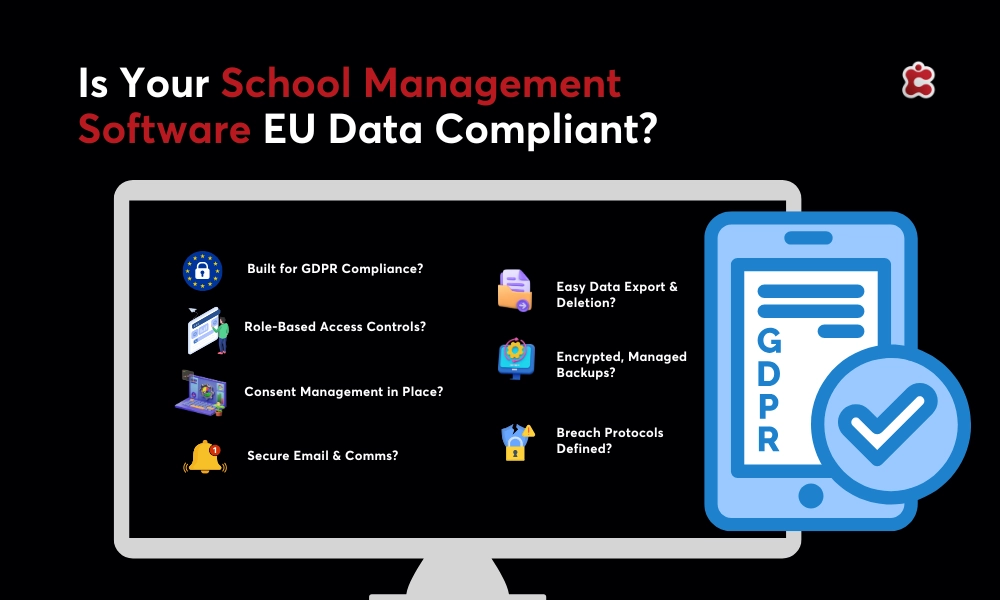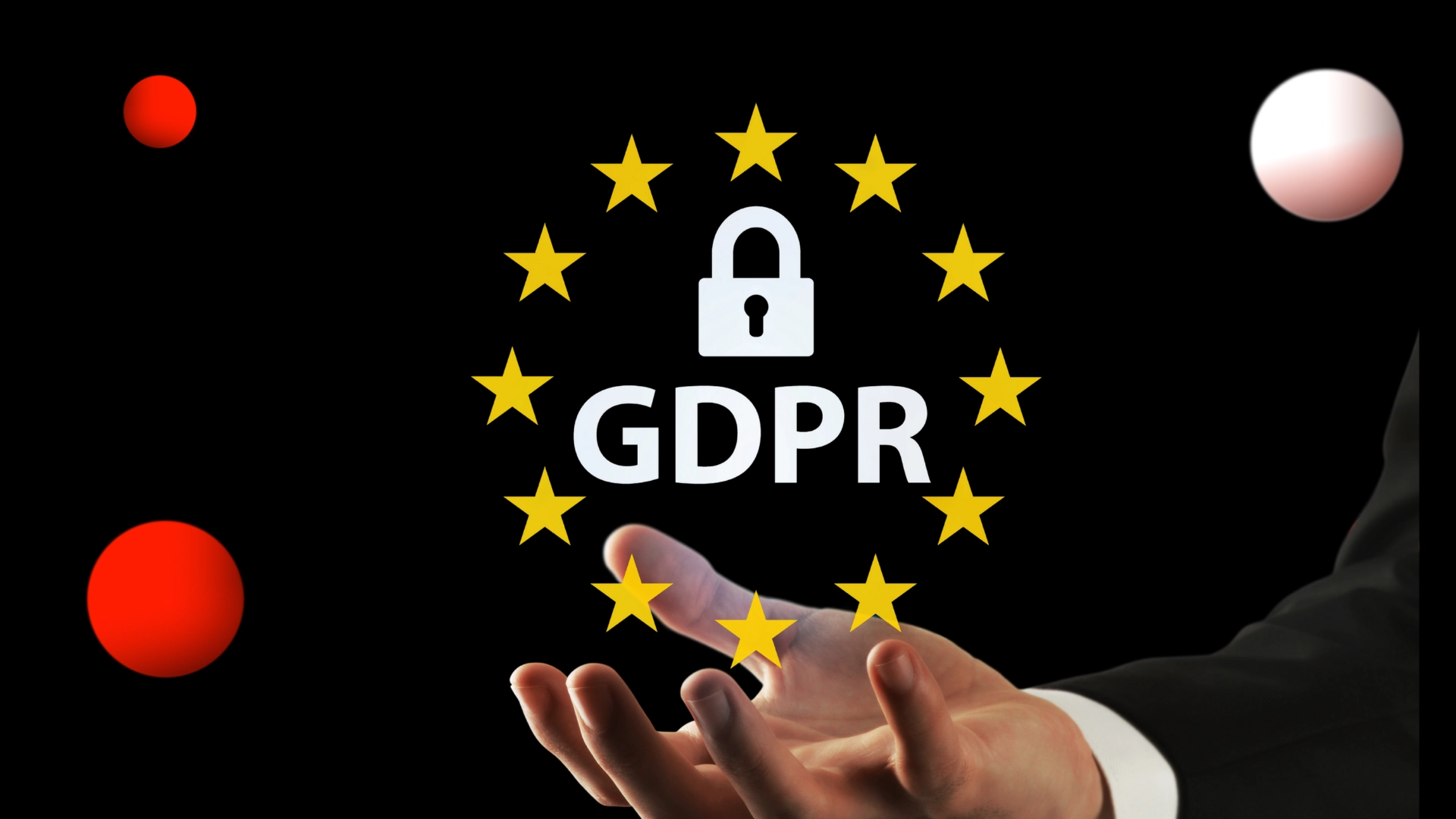In 2018, the EU implemented GDPR (General Data Protection Regulation), a common data protection law across the European Union. Since then, it has transformed how institutions handle personal data, especially in education, where sensitive information is everywhere. Alongside GDPR, regulations like the ePrivacy Directive and various national laws create a strict framework for how data should be collected, stored, accessed, and shared.
For higher education institutions, the risks of non-compliance are real. Fines can be significant, but the reputational damage and loss of trust from students, parents, and staff can be even more damaging.
Many institutions have implemented School Management Software (SMS) to manage their day-to-day operations more efficiently. But here’s the important question: Is your SMS actually helping you stay compliant with EU data protection laws?
We provide you with a practical checklist to help you find out. You’ll be able to spot any compliance gaps, understand your risks, and feel more confident that your software is supporting your data protection responsibilities.

1. Is Your Software GDPR-Compliant by Design and Default?
Your School Management Software should support GDPR compliance through its core design and day-to-day functionality. “Privacy by design and by default” means data protection is built in from the start.
Look for these features:
- Legal Basis for Processing: Define consent, contracts, or legitimate interest clearly.
- Transparency: Show clear privacy notices and data usage policies to users.
- Data Minimization: Collect only the data that is strictly necessary.
- Purpose Limitation: Use data only for the purpose it was collected.
- Accuracy: Allow easy updates to keep information current.
- Storage Limitation: Set rules to automatically delete outdated data.
- Security: Use encryption, access controls, and audit logs.
- Data Subject Rights: Support access, correction, deletion, and objections.
- Data Protection Officer (DPO): Provide a way to manage DPO-related communication.
- Data Protection Impact Assessment (DPIA): Include tools for high-risk data processing assessments.
2. Can You Control and Limit Data Access for Different User Roles?
Not everyone in your institution needs access to the same information. A GDPR-compliant School Management Software should help you limit access based on user roles, reducing the risk of data exposure and human error.
- Role-Based Permissions: Can you assign different access levels to teachers, administrators, finance staff, or IT? For example, a teacher should view grades, not financial records.
- Sensitive Data Restrictions: Does the system prevent unauthorized users from accessing student health or disciplinary records?
- Audit Trails: Is every login, access, and edit recorded? Audit logs help you monitor activity and support accountability.
- Multi-Factor Authentication (MFA): Does your SMS require more than just a password for admin-level users? MFA greatly strengthens security.
3. Does Your System Track and Record Consent Properly?
Consent is one of the cornerstones of GDPR. For higher education institutions, this includes everything from data sharing agreements to using student photos in marketing materials. Your School Management Software should make it easy to collect, track, and manage consent in a secure and transparent way.
First, check if your system allows students or guardians to provide digital consent through online forms or portals. These should be easy to access, written in clear language, and tied to a specific purpose. Once given, each consent record should include a timestamp to show when and how it was collected.
Just as importantly, your SMS should let users review, update, or withdraw their consent at any time. Whether it’s a parent changing their mind about photo usage or a student opting out of promotional emails, the system should honor that choice quickly and without friction.
4. Is Email and Communication Tracking Secure and Compliant?
Encrypted Communication Channels
Your platform should use secure email protocols like TLS or SSL to protect messages in transit. This ensures that sensitive information—such as student updates or billing notices—is shielded from interception or unauthorized access.
Consent and Notification Preferences
Students, staff, and parents should have control over their communication preferences. Can users opt in or out of non-essential notifications? A compliant system respects consent and makes it easy to update preferences at any time.
Marketing and Privacy Compliance
If your SMS sends marketing emails or newsletters, it must comply with both GDPR and ePrivacy rules. This means getting explicit consent, offering clear unsubscribe options, and maintaining accurate records of communication preferences.
5. Can You Easily Obtain, Export, and Delete Student Data?
Under GDPR, individuals have the right to access their personal data, request its transfer, and ask for it to be deleted. Your School Management Software should make it simple to honor these requests without involving complex workarounds or manual processes.
Start by assessing how easily you can retrieve and export a student’s data. Whether a student is transferring to another institution or simply exercising their Right to Access, your system should provide data in a structured, commonly used format that’s easy to share securely.
Equally important is the Right to be forgotten. If a student requests deletion of their personal data, your SMS should allow you to carry this out fully, while also keeping a record of the deletion for audit purposes. A clear deletion process, backed by audit trails and activity logs, helps demonstrate compliance and builds trust with students and their families.
6. Are Backups Encrypted and Properly Managed?
Even the most secure systems can face unexpected incidents. That’s why backups play a crucial role in your data protection strategy—but only if they’re handled correctly and compliantly.
Look for these key backup features:
- Encryption in transit and at rest: All backup data should be encrypted when being transferred and when stored, ensuring it’s protected from unauthorized access at every stage.
- Defined retention policies: Your SMS should allow you to control how long backups are stored. Keeping backups longer than necessary can expose your institution to compliance risks.
- Granular restoration capabilities: In the event of data loss, you should be able to restore specific user data or records—without having to restore the entire database.
7. Is There a Clear Protocol for Data Breaches?
Breach Notification Process
Your provider should have a defined process for detecting and responding to breaches. This includes identifying the scope, containing the threat, and preparing reports. Under GDPR, authorities must be notified within 72 hours; therefore, quick internal escalation is crucial.
Timely Alerts to Institutions
Can your SMS provider notify your institution quickly if a breach occurs on their end? Delays can result in regulatory penalties. Look for providers who commit to prompt alerts so your team can act fast.
Incident Logging and Reporting
Accurate records of breaches, including dates, impacted data, and resolution steps, are essential. Your SMS should log all incidents and make those logs accessible for audits, reviews, and institutional accountability.
Classter Takes the Hassle Out of Compliance
At Classter, we understand that compliance isn’t just a checkbox—it’s a foundation of trust. That’s why our all-in-one School Management Software is built with full GDPR compliance at its core. From the moment data enters the system, privacy-by-design principles guide how it’s stored, processed, and accessed. Role-based permissions, encrypted backups, consent tracking, and audit logs are all seamlessly integrated, so your institution can stay compliant without added stress.
We’ve done the heavy lifting, so you don’t have to.
Ready to simplify compliance and protect your students’ data with confidence?
Book a personalized demo and discover how Classter can support your institution’s journey to smarter, safer school management.

